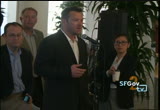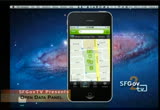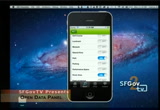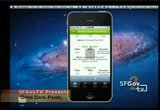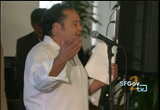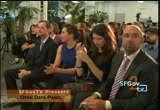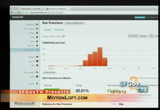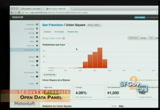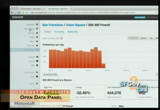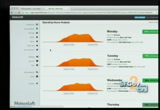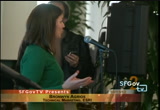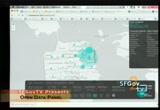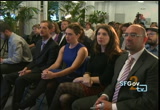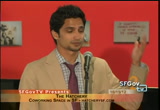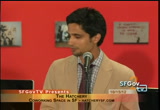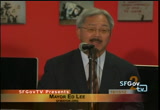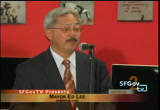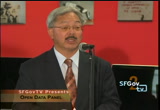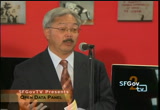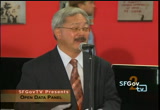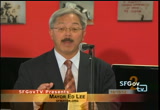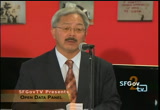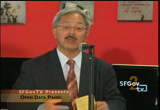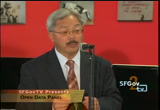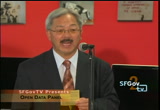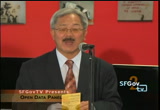tv [untitled] January 10, 2013 9:30pm-10:00pm PST
9:30 pm
our breakout sessions. take this opportunity to use the west -- the restaurant and find your own way. thank you. -- rest room and find your own way. thank you. >> so, we're just going to take you through this really quickly. over 200 parks, over 1100 facilities are all contained within this. everything is based around you as a human being have your app. if you're looking for a park or if you're not familiar with any of the parks here in the city are, this app is a perfect
9:31 pm
accessory. so we're basically zooming in on the map right now. you can see the clustering 2 12 parks. as you get closer in, it lets you know where you're at. i'll zoom in on a park. you can see many different parks here. if you go to dolores, we'll start to see all of the facilities that they have available. looks like there's a tennis court, a dog play area, some children's park play areas. and if you actually go into one of the children's play area maybe, you can see some details about it. any news about each of the parks is going to be referenced
9:32 pm
here through a feed. ability to donate to the rec and park. let's say a ballfield, you'd be getting ballfield information. if there's close out based on rain. and you can do some filtering, spot-check the filtering real quick. this is what's near right now. filter, we've got, i don't know, what is it, over 10 categories, maybe closer to 20. and basically anything you're looking for, you can turn on right here. for me, i'm a dog owner. maybe i want to take the kids as well. and i want to find a park that has all of these things. i filter, i go back. i'll find which ones are the closest via the list or the map view. and then when you actually go ahead and click on any of these parks, you'll be brought to --
9:33 pm
you should be brought to the ones that have actual dog parks and the other filters that were put on the picnic area. so, there you see you've got dog play area, picnic area. additionally, there's feedback that can be pushed through this. any reservations for the picnic areas in park and rec, golden gate park has quite a few. you can actually go ahead and begin to do reservations on here. you just choose your picnic table and go through this. you can also search for whatever it is that you're looking for. if you're looking for dolores
9:34 pm
park, we just did a search for dolores, brings you right to it. you can go inside and take a look at what's available there. and you can also get directions. zoom back in on this. and, so, very simple, just direction. does anyone have any questions? okay. we've got about 8 minutes until we've got the mayor coming on. so -- >> [inaudible]. >> hi, i'm the founder and ceo of apple-liscious. a couple things to talk about for the mobile app. we built the platform for the department of rec and park. looking towards the future, which is really kind of what
9:35 pm
bill ginsler was doing, making information first, but second, adding the financial component, making transactions which we have built into the mobile commerce platform with the hierarchical structure from the top down, enabling the city to actually manage all of their own financial transactions. from ticketing, reservations, permitting, just about every component you can think of, of interacting with the city as a business itself, which most people -- which is kind of a big differentiation factor in developing this. so, as far as creating access to the public, using the open data sets, and creating exposure to neighborhoods that you probably traditionally didn't even think were there, we realized there were 1200 different facilities all through the park -- all through the city as we were going out to explore. and upon our own discovery, and i being a local native, i didn't know about 800 of them. so, as we move forward into the
9:36 pm
future, taking this, working with some other departments like san francisco arts, we're creating access for people, creating efficiency with the government being able to manage transactions, creating a platform for people to actually interact with the city on a level that hasn't been done before. so, ideally, using the san francisco rec and park, the future san francisco arts app, using our mobile commerce to manage that is creating jobs, revenue, and efficiency for the public and tourists to be able to navigate san francisco in a way that hasn't been done before. thank you. >> all right. (applause) >> so, we're going to show another application from motion launch, the founder and ceo, john, will be sharing some of the work that they're doing. they're based here out of san francisco and they've got a
9:37 pm
great announcement to make. >> i am jon mills. i'm ceo of motion loft. we started about three years ago developing sensors that we could place around cities that would give us some analytics on how people move around cities and how vehicles drive around cities. so, currently we have 16 neighborhoods -- 18 neighborhoods covered in san francisco, and we get real-time data back that shows exactly how many people go by some of the busiest areas in san francisco. so, you can see here san francisco, on average total, i think we had 150 people cross our sensors on average for every sensor. in case you want to go into time density. so, we end up getting these
9:38 pm
really, really great visualizations of the busiest times and the least busiest times of people moving around san francisco. you want to go down into union square? you can see the data changes dramatically when we change the neighborhood. and just illustrates how different every neighborhood in san francisco really is. we're announcing today that we're providing some of this data to the city as a kind of public service to help the citizens here figure out how many people walk around their neighborhood. but mostly it's to help public service, like the fire department, the police department, the mta know more about how people move around. so, we're providing crowd data. so, if a thousand people pass one of our sensors in an hour, that data will be available publicly.
9:39 pm
every month. so, chris, do you want to go a little deeper? >> you can see we have a lot of blocks around union square covered. when you show this data to property owners and real estate agents and to retailers, they want to know more about how much -- how many people walk in front of their store every day, kind of the story -- the way i thought of the idea was standing in my balcony looking down at walgreens and realizing they had no idea how many people pass their store every day. they don't know that, how do they know if they're successful because the weather is nice, or because they did something right. so, you want to go into business hours? the wi-fi store here. so, one of our clients is saks fifth avenue and we end up giving them some really great
9:40 pm
charts about how many people pass while they're open. so, you can see here. these are the hours that they're open. and the dark areas are the hours that they're closed. and if they're open from 10:00 to 7:00 p.m., they capture 81% of the people that walk by. so, that might mean that they want to move their hours one way or the other and capture more people, or stay the same. and it's just data they didn't have before. and i think you can imagine what 5% more people, more customers to a big retailer would be in revenue. i can't tell if they're trying to cut me short or telling me to keep going. [laughter] >> this wasn't even -- this wasn't even part of it. i guess people are just late. so, i get up here. all right. yeah, so, if you go down and in our interface, this is a web app that's available to all our customers, you can see here the busiest day in san francisco is friday.
9:41 pm
the busiest time, the busiest hour on average is 1:00 to 2:00 p.m.. on september 14th was the busiest day of last month. and the people can line this data up with their sales data or with public transit or anything they're looking at and they'll be able to figure out real quickly if there's a correlation. and if there's more pedestrians, less pedestrians. what? >> [inaudible]. >> i'm sorry? >> [inaudible]. >> so, this is a tool that we're developing based on the data that we're announcing today. you can see them over here a little bit better. but you can see that to most departments, most agencies in san francisco, the city, most agencies, they'll be able to use this in a real way. they'll be able to look -- police can look at an interface and be able to see exactly how many people are in these areas that they might have to go to
9:42 pm
-- kind of wrap up now, i guess. no, i can't. so, you know, and we can also show predictive data about when the giants are going to be playing. so, anyway, you can come over for a demo later. i think we'll be on a panel later. now i think it's the mayor's turn. (applause) >> okay, everybody, [speaker not understood]. we've actually been working with the city the past few weeks to try and consume some of the data that's a part of the data sf data repository and tell a story about urban growth. so, this is a mapping platform that allows you to not only visualize your data like you see here, but also ask questions of your data. and i'm pulling data from multiple data sources. here we have data from the city. we also have data from private data sources that read -- not
9:43 pm
going to mess with it. there's one of the variables now, the bottom you see there is median household income. we're pulling in all these different data sources, creating a beautiful visualization to tell a story at the neighborv level of how the city is growing. and some of the things you're seeing on the map here are a pipeline of information about both residential permits over the past decade or so, how has the city allocated permits throughout different neighborhoods in the city. and some of the other things you're seeing on the map is the approved businesses, the businesses are currently doing business in the city. one of the things we said once we started visualizing on the map the slow and more rapid growth of residential --
9:44 pm
residential property in soma and then in 2011 you just saw obviously a huge residential boom in the downtown area. so, we've just actually -- we're a company in southern california. we just relocated up here, small little office in san francisco, trying to better understand the community moving at a fast pace here. part of doing that is working with the city and better understanding how we can support open data. so, thank you. (applause) >> good morning, everybody. can you hear me? good morning and welcome to the hatchery. this is our newest space. my name is rajul pakash, i'm one of the founders. along with my other partners, chris and richy in the back, and lawrence who could not make it.
9:45 pm
welcome to 6 45 harrison and the hatchery. it's super exciting to have such a dynamic group of people from both the public and private sector here today. and as a self-proclaimed geek and tech entrepreneur, this is really exciting for me. before i wax on about that's correct really quickly want to give you just a quick 90-second thing about the hatchery. we opened our doors about a year ago at 625 2nd street, bought 21 thou square feet there. we opened our doors and within a year we've grown into a whole new space which we opened two months ago. * across both spaces we have about 135 companies and it's sort of awesome. they are not all tech. we sort of range from writers and virtual wineries which are right behind me. to some of the leading technology companies in the valley. we have companies that raise anywhere from a thousand dollars to $25 million that have sort of been housed with us. some of the coolest things that have happened at the hatchery two people sitting next to each
9:46 pm
other working on the same app for six months decided to merge and raise a million dollars for their company. so, collaborative consumption is something we truly believe in and having spent a couple of years working with the likes of jane, brian, tina lee and a bunch of other people who have been sort of working on this open data problem, it's been sort of exciting to sort of see it come to fruition today and see sort of the progress that they've made. so, for me this is sort of -- it's been fun to sort of watch this team of people come together and do what they do and make san francisco a 21st century city. so, you know, it's an honor to welcome the mayor back to the hatchery, the new hatchery. we invite you, supervisor chiu, to our monthly infamous happy hours where bourbon and branch caters to meet with our tenants. it's an honor to have you guys here. enjoy the day and it's an honor to welcome jane back to the hatchery. (applause)
9:47 pm
>> good morning, my name is jane. i'm the mayor's chief innovation officer. before we get things started, i'm actually going to have one more company come up here because we're actually waiting for the press to get finalized and set upful. so, a couple more minutes to read here. how much time, press? no one is giving me any signs here. you guys are ready, great. so, we're going to hold off and have you guys come up a little bit later. so, again, my name is james. i want to thank the hatchery for hosting us here and being such an important part of the start-up community and for helping san francisco businesses start and grow here in san francisco. our first speaker is mayor lee. he has been a strong advocate of open data, both in his current position and also historically as the city administrator. and he's going to be sharing with you some really exciting announcements and his vision for open data. mayor? (applause)
9:48 pm
>> hi, good morning. welcome again to innovation month in san francisco. it's great to be here. as you know, i've been working really hard with organizations like sf city and code for america and others to make sure that we keep being leaders in technology and celebrating our status, but also implementing the programs to help us continue that very nice title we have, the innovation capital of the world. and i am here today in collaboration with board president david chiu and so many others from our committee on information technology, spur, our different various city departments, really trying to improve on what we've done already. back in 2009 then mayor gavin newsome to the light of all of us had introduced that we ought to really establish some guidelines to open up our city's data. and in the year later, the
9:49 pm
board, less legislation, the first open data legislation in san francisco that made us cutting edge throughout the country, the first to come out and say to everybody in the public, to people who wanted to create businesses, wanted to look at the city with kind of an open invitation to involve themselves with what the city had. and part of that really neat understanding was that we were holding onto so much of our own data in our own silos with our own very focused obligations that we had, and not realizing that if we had released that data to the public, we could really allow them to help us create even more efficient government, along with some very good entrepreneurial efforts that are reflected in today's announcements and some of our partners that are here today. so, three years later, after announcing this and after doing the first generation of open data legislation, open sf is still a very vigorous, and we
9:50 pm
want to do even more. we've teamed up again with board president david chiu who has been personally involved with this and helping us and guide us with his knowledge, having been a small business owner himself, with how we can do even better. and today we are announcing actually two areas of improvements to our piece of legislation that i think will get people even more excited. the first is after a couple of years of opening up some of the data streams in our city and seeing how this data had already started, some companies, some entrepreneurs develop applications, helped us already with identifying some additional needs in the city and involving more people, we want to do even more along that line. and, so, this legislation will allow us to establish, along with the best practices that are going on in new york, chicago, and the sunlight foundation, that is to create a position in the city, basically establishing a data office, an
9:51 pm
open data officer for the city, somebody that's going to help jay naff. jay is like our external innovation officer. he's helping me connect up all the time with all of the different companies in the city that are establishing and creating things. but i need somebody on the inside. we have a 60-department bureaucracy. they're still working in a lot of different silos and one of the things that we still have to do is get them on a higher level of sharing their data. so, establishing a chief data officer for the city that will work with all the different departments, establish some additional standards for them to create pinpoints in every department of what their data is, what they may not be aware of that they're collecting and computers in our departments and allow that data to flow out. this will be a good addition and a great improvement. it is part of the best practices that we're learning across the country that if we
9:52 pm
establish a data person, person that will really look for opportunities and establish them with the departments and bring more data out, that will improve our city's performance. the other roll out we're having today, government for the last three years, our government has really been on both the pressure point and i think now realizing a tremendous opportunity to allow our data to go out. why not also in return ask for companies who are also collecting data to share that with city government? that's another great exchange that we have. and i know there's a lot of companies out there that do collect a lot of data, whether they're your credit card companies, your banks and so forth. if there is a way that their data can come to us, it might very well be the grounds for even better public service for all of our different
9:53 pm
departments, whether we're talking about health or sports or kinds of things that our public would use. and i want to serve up an example. there's been a company here in san francisco called motion loft and they have been creating sensors in various departments. they've covered some 18 different neighborhoods in our city with thousands of different sensors to track pedestrians, vehicles, maybe later on they'll tag bicycle traffic. and that data in the various neighborhoods have, i think, been incredible for their company to launch and to work in collaboration with other companies to see how movement in the city can help us establish patterns, trends, and other things. and they're going to share that data with us. and i believe that data is going to be value with us as we figure out challenges like the
9:54 pm
small businesses along west portal or in terra val, along 3rd street who see their vacancies and they ask the mayor, how can you invest in neighborhood strategy work a little better with us to attract people to come and be customers in our neighborhood, coffee shops, restaurants, salons and other things? how can we do that? we've always scratched our head saying, you kind of have to do it yourself. you have to create your ideas yourself. and now we're saying, well, maybe there is data out there that could help establish some best practices, can help maybe quicken the ideas of what might be more attracted to our smaller neighborhoods. well, this is the kind of data out there, analytics, if you will, the analytical model that are being created by our local san francisco companies like motion loft and others, who are using these data yet can share it with the government as motion loft has agreed to do today, as part of yet another
9:55 pm
exciting phase. and you ought not be surprised when we ask some of the larger companies and suggest to them that we can be a better city if they share their data through data sf with us. and if we can then download it and have it available to everybody else, i think that that would be a great combination. these are a couple of the improvements that we wanted to announce today in our open data legislation in collaboration, again, with our board. but also in collaboration with code for america who has been working with us, with sf city as i mentioned earlier, spur, our department of technology, our committee on information technology, and then we have an open data working group which really tries to get volunteers from the different departments to work together and see what other kinds of data analytics that we could provide to the public. i want to just say today, you're going to hear some
9:56 pm
demonstration projects that are already started with our open data. again, as a way to celebrate innovation month, not only are we opening up different companies throughout san francisco, but we want to also encourage, examples we're going to be announcing yoyo working with phil ginsberg to provide data where are small parks or where the events are happening. what is the cost? how to get there in the hours that they're operating? a smart phone application for all of our events in recreation and park department, that to me is going to be invaluable to visitors and to our neighborhoods. bronwin who is working with us on data information from neighborhoods in our city, growth trends, that kind of data certainly is going to help
9:57 pm
a department like city planning who is trying to kind of figure out where the new neighborhoods in our city, what do we do from a planning and zoning effort, prioritizing. is it small businesses now in pier 70 area or do with we go high-rises downtown? what kind of people trends and business trends and constituent trends are happening in our neighborhoods * ? that data is there to be shared with our city planning. so we can plan for the future and make sure when we're not planning to limit the kind of growth that we want to encourage. and then we've got another exciting one. chris haug is here and the company hundred-plus is here today. they have worked on, for many years, health related data. and they're going to roll out the opportunity where people can get information about what
9:58 pm
exists in our city that they can utilize or go to that will affect their health in a positive way. for me, i'm looking at an apparatus that will be on my wrist that will tell me every time i should go to the golf course. [laughter] >> because that's where my exercise happens. the more i walk on the golf course like i did 18 holes yesterday morning at 6:00 a.m., the more healthy i'm going to be in the long run. it's things like that where people don't know there might be an existent location that they don't know about that could be related to their health. and they could have that instantaneously. these are just three of some of, i think, just hoards of examples that when we allow data analytics and this is really to me a technology geek's really dream, is to have all of this data available so that we can mine them in different ways and very creative ways. and i want to say, again, as someone who has worked in
9:59 pm
government for 23 years, i've been at those departments like dpw and others where we think in one dimension. this is where we clean the streets. this is how often we clean it. this is when we tell the cars to move off. and this is what dpw does and it does it pretty well within that constraint. if you shared that data with companies who are looking at where do people live, how -- what their patterns are, we can get a lot more creative. when we open our data, when we suggest to departments that they can work in collaboration, when we open up and establish within our city contracts that the companies that do service for us do not own the data that they generate from us, that they will have a contractual obligation to share that with the city so that we can mine that to the rest of the city, that's advance of opportunities for everybody.
50 Views
IN COLLECTIONS
SFGTV2: San Francisco Government Television Television Archive
Television Archive  Television Archive News Search Service
Television Archive News Search Service 
Uploaded by TV Archive on

 Live Music Archive
Live Music Archive Librivox Free Audio
Librivox Free Audio Metropolitan Museum
Metropolitan Museum Cleveland Museum of Art
Cleveland Museum of Art Internet Arcade
Internet Arcade Console Living Room
Console Living Room Books to Borrow
Books to Borrow Open Library
Open Library TV News
TV News Understanding 9/11
Understanding 9/11
